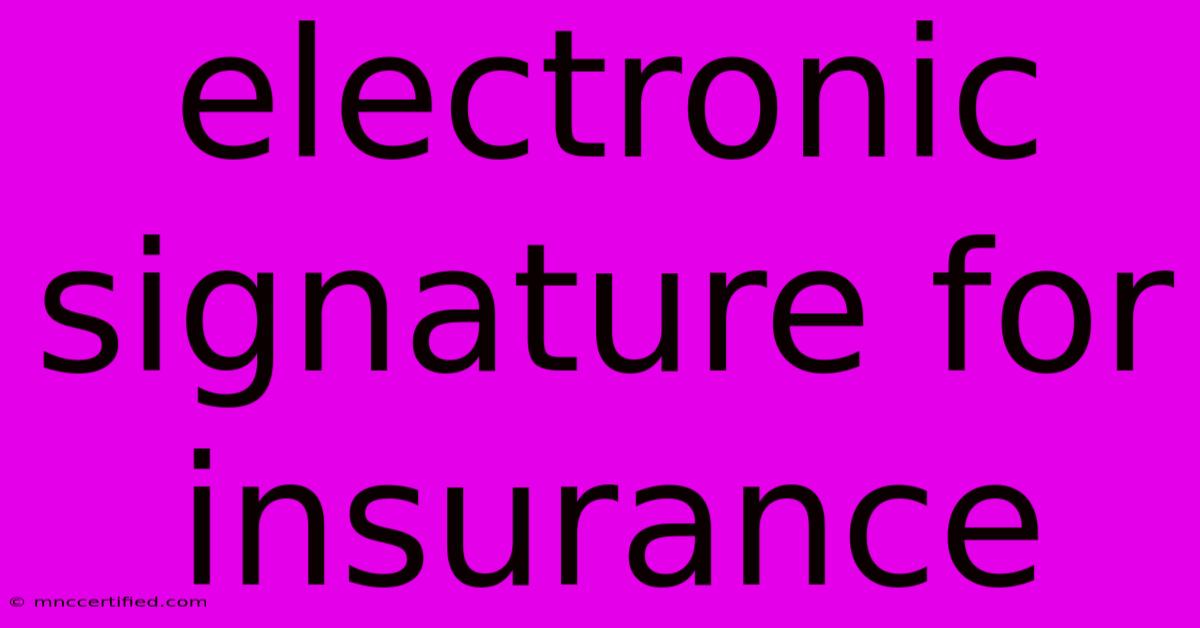Electronic Signature For Insurance

Table of Contents
Streamlining Insurance: The Power of Electronic Signatures
The insurance industry, traditionally reliant on paper-based processes, is undergoing a significant digital transformation. At the heart of this change lies the electronic signature (e-signature), a technology revolutionizing how insurance policies are signed, managed, and processed. This comprehensive guide explores the benefits, challenges, and best practices surrounding the use of electronic signatures in the insurance sector.
Why Choose Electronic Signatures for Insurance?
The adoption of e-signatures offers numerous advantages for both insurance companies and their clients:
Increased Efficiency and Speed
- Faster policy issuance: Eliminating the need for printing, mailing, scanning, and physically filing documents drastically reduces processing times. Policies can be issued and signed within minutes, not days or weeks.
- Reduced operational costs: Lower printing, postage, and storage costs contribute to significant savings. Automation of the signing process also minimizes administrative overhead.
- Improved workflow: E-signatures integrate seamlessly with existing insurance systems, streamlining workflows and enhancing productivity across the entire insurance lifecycle.
Enhanced Customer Experience
- Convenience and accessibility: Clients can sign documents anytime, anywhere, from any device with internet access. This flexibility caters to busy schedules and diverse lifestyles.
- Improved satisfaction: Faster processing times and a more user-friendly experience lead to higher customer satisfaction and loyalty.
- Reduced paperwork: Clients no longer need to print, sign, and mail documents, reducing frustration and administrative burden.
Enhanced Security and Compliance
- Audit trails: E-signature platforms provide detailed audit trails, documenting every step of the signing process, ensuring compliance with regulatory requirements.
- Data security: Reputable e-signature providers offer robust security measures to protect sensitive client data, complying with industry regulations like HIPAA and GDPR.
- Legal validity: E-signatures are legally binding in most jurisdictions, providing the same legal weight as traditional handwritten signatures. Ensure compliance with relevant state and federal regulations for legally binding e-signatures.
Challenges of Implementing Electronic Signatures in Insurance
While the benefits are substantial, some challenges need addressing:
- Integration with existing systems: Integrating e-signature technology with legacy insurance systems can be complex and require careful planning.
- Security concerns: Choosing a reputable provider with robust security measures is crucial to protect sensitive client data.
- Client adoption: Educating clients about the benefits and security of e-signatures is essential to ensure widespread acceptance.
- Regulatory compliance: Understanding and adhering to relevant regulations concerning electronic signatures is paramount.
Best Practices for Using Electronic Signatures in Insurance
- Choose a reputable e-signature provider: Select a provider with proven experience in the insurance industry, robust security features, and strong compliance certifications.
- Clearly communicate the process to clients: Provide clear instructions and support to ensure clients understand how to use the e-signature platform.
- Ensure compliance with all relevant regulations: Familiarize yourself with and adhere to all applicable laws and regulations regarding electronic signatures in your jurisdiction.
- Implement strong security measures: Protect client data by implementing robust security protocols, including multi-factor authentication and encryption.
- Maintain detailed audit trails: Regularly review audit trails to ensure compliance and identify any potential security breaches.
The Future of Electronic Signatures in Insurance
The use of electronic signatures in the insurance industry is poised for continued growth. As technology advances and regulations evolve, we can expect even greater efficiency, enhanced security, and improved customer experiences. The integration of e-signatures with other emerging technologies, such as AI and blockchain, will further transform the insurance landscape. Embracing e-signatures is no longer a luxury but a necessity for insurance companies seeking to remain competitive and provide exceptional service to their clients. Staying informed about industry best practices and evolving regulations is crucial for successful implementation and continued compliance.

Thank you for visiting our website wich cover about Electronic Signature For Insurance. We hope the information provided has been useful to you. Feel free to contact us if you have any questions or need further assistance. See you next time and dont miss to bookmark.
Featured Posts
-
Turner Debuts As Wi Wins Toss
Nov 17, 2024
-
Texas Football Holds Off Arkansas
Nov 17, 2024
-
Alternative Balance Yoga Insurance
Nov 17, 2024
-
Check Expiry Date Of Car Insurance
Nov 17, 2024
-
Brightway Insurance Gainesville Fl
Nov 17, 2024